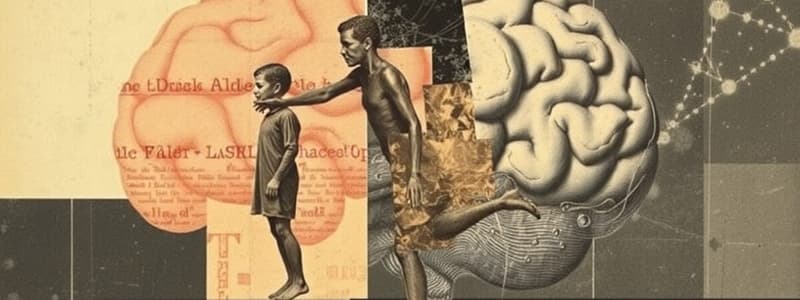Podcast
Questions and Answers
What is the primary focus of motor development?
What is the primary focus of motor development?
- The influence of sports on adolescence
- Changes in growth and motor performance throughout the lifespan (correct)
- Changes in dietary habits across ages
- The impact of technology on physical performance
Which of the following factors does NOT influence motor performance?
Which of the following factors does NOT influence motor performance?
- Heredity
- Environment (correct)
- Experience
- Maturation
What is the sequence of motor development starting from the head to the toes called?
What is the sequence of motor development starting from the head to the toes called?
- Proximodistal
- Cephalocaudal (correct)
- Radial growth
- Distal-proximal
Which type of reflex is characterized by responses that are essential for survival and serve as diagnostic tools?
Which type of reflex is characterized by responses that are essential for survival and serve as diagnostic tools?
What is the term for skills or behaviors that are naturally acquired and associated with the species of man?
What is the term for skills or behaviors that are naturally acquired and associated with the species of man?
What is the correct order of locomotion development?
What is the correct order of locomotion development?
Which of the following is an example of ontogenetic behavior?
Which of the following is an example of ontogenetic behavior?
What encompasses the early stages of manual control in prehension development?
What encompasses the early stages of manual control in prehension development?
Flashcards are hidden until you start studying
Study Notes
Motor Development
- The study of change in growth, development, and motor performance across the lifespan.
- Similarities exist in motor development between infants and elderly individuals.
Factors Influencing Motor Performance
- Heredity: Genetic predisposition for specific abilities.
- Maturation: Biological processes that occur with age.
- Experience: Practice and repeated exposure to skills.
- Development: Changes in physical and cognitive abilities.
- Growth: Increase in body size and proportions.
Brain and CNS Development
- Cell Proliferation: Generation of immature neurons.
- Migration: Neurons move to specific locations in the brain.
- Integration: Formation of connections between neural groups.
- Differentiation: Specialization of neurons for specific functions.
- Myelination: Coating of neural pathways with myelin for faster transmission.
- Cell Necrosis: Death of neurons.
Growth and Control Sequence
- Cephalocaudal: Growth proceeds from head to toe.
- Proximal-distal: Growth proceeds from the midline of the body outwards.
Phylogenetic and Ontogenetic Skills
- Phylogenetic Skills: Species-specific, naturally acquired without specific training. Examples: Crawling.
- Ontogenetic Skills: Learned skills that depend on individual experience. Examples: Dancing.
Reflexes
- Definition: Involuntary responses to stimuli.
- Fate: Infant reflexes are suppressed over time.
- Importance: Diagnostic tool for assessing neurological health and survival mechanisms.
Categories of Reflexes
- Primitive: Basic reflexes present at birth (e.g., sucking, grasping).
- Postural: Related to maintaining balance and posture.
- Locomotor: Similar to voluntary movement patterns (e.g., stepping).
Spontaneous Movements
- Rhythmic, repetitive movements observed in infants.
Creeping vs. Crawling
- Crawling: Body drag, using the arms to pull the body forward.
- Creeping: Movement on all fours, using the hands and knees for propulsion.
- Sequence: Creeping usually precedes crawling.
Stages of Prehension
- Palmer Grasp: Using the whole hand to grasp an object.
- Pseudo Opposition: Using the thumb in a crude way to grasp an object.
- Thumb Opposition: Using the thumb to oppose the fingers for precise grasp.
- Mastery: Developing advanced and efficient grasp patterns.
Sequence of Locomotion Development
- Crawling
- Creeping
- Walking
- Running
- Leaping
- Jumping
- Hopping
- Galloping
- Sliding
Peak Performance Age
- Skills requiring fast reflexes peak in the 20s.
- Skills requiring strength peak in the 40s.
Adult Physical Functioning Decline
- Adults typically lose approximately 20% of their physical functioning between ages 30-70.
Studying That Suits You
Use AI to generate personalized quizzes and flashcards to suit your learning preferences.




